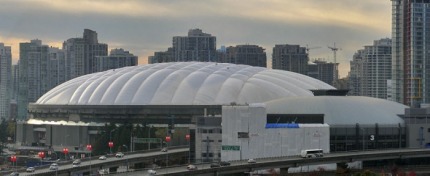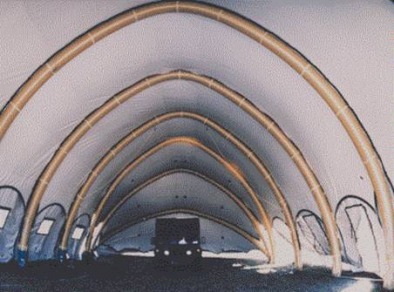Our Structural System
The structural system our design team has chosen is a pneumatic structure. A pneumatic structure is a system utilizing air pressure to support a fabric roof and often times walls bound by cables as opposed to the use of concrete, wood or steel. The key criterion driving our structural selection is that our facility is to be temporary. We wanted the ability to construct, demolish, and relocate our facility in a relatively short time and at low cost. Other structural systems containing components such as steel, concrete, and wood might possess some of these qualities if not all three, but only on a small scale. Our facility is a large exhibition center, and when using those components, the larger the spans and the larger the height become the more and more "permanent" the structure becomes. Permanent meaning increased construction/demolition/relocation time and cost. While we have decided on one clear span, it is the option for exhibitors to bring dividing walls to isolate their exhibits. We also note that some exhibits might be very tall, which is something a pneumatic structure can easily accommodate for at low cost. This is because of this systems extremely low weight to height ratio and weight to span ratio. Any other structural systems becomes significantly heavier the taller you make the structure relative to extremely lightweight pneumatic structural systems.
Potential Problems
While a pneumatic system may be the most temporary structural available it does have its' drawbacks. Such as cost of operation. In order to inflate and to maintain inflation of the structure relies on mechanical equipment, fans, that must always be on to maintain stability. However, because this facility is for temporary use, the cost of operation is insignificant when you consider other costs associated with other structural systems. Another concern is high traffic volumes of people entering and exiting the facility which causes problems in maintaining air pressure for structural stability. As people enter and exit air pressure is lost. This is easy to account for when a low volume of people are entering and exiting the building and at low frequency. However the nature of an exhibition center often involves high volumes of people entering/exiting sporadically. However, there are two ways to help with this 1) there are special entry and exit systems designed to minimize loss of air pressure, the utilization of these doors could help maintain structural stability and 2) instead of inflating the entire open space with air, utilize air columns to support the structure. This eliminates the need to maintain air pressure throughout the entire open space. Pneumatic structures are also susceptible to wind loads and live loads such as snow. The easiest solution for these two problems actually conflict with each other. Typically to avoid wind loads a shallow pitched roof/dome is built. While to avoid accumulation of snow high pitched roofs/domes are used. So the answer here is to design for a low pitch roof to account for the wind load and to install heaters near the ceilings to melt snow and prevent any accumulation.
Conclusion
While there are several short comings to using a pneumatic structure, there are also several techniques that can be applied to avoid any serious issues. But of course the applications of these techniques do not come without an expense. However, because this is a temporary structure these expenses are highly unlikely to match the construction and demolition costs of any other suitable structural system. So in conclusion, the convenience and versatility of a pneumatic structures cannot be matched when the lifetime of a structure is only temporary and meant to be reused.




